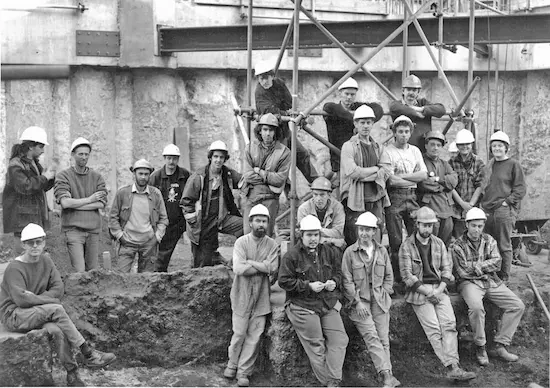The port of Roman London revisited at Regis House
Quintin Waddington
In 1929-31 the construction of the new basement of Regis House, in the City of London involved the hand digging by labourers of numerous deep stanchion bases.
Fortuitously, my colleague Gerald Dunning the Guildhall Museum field archaeologist closely monitored this work, which revealed a thick red layer of Hadrianic Fire debris packed with burnt Samian overlying a series of massive, squared, oak timbers, which looked to me rather ‘like a row of gargantuan cucumber frames’ (p. 6), but others assured me that it was really a Roman Thameside wharf, which we now know was the Neronian quay. The site’s developer Rudolph Palumbo (his son Peter, now Lord Palumbo in the 1990s developed No1 Poultry) generously agreed in1931 to publish a little book I wrote about the history of Regis House, entitled: The Story of Regis House, King William Street. Therefore, when I was invited to pen a few words about the subsequent archaeological work carried out during 1994-96 by the Museum of London Archaeology Service (MoLAS), I was delighted.
It is amazing that 63 years after this imposing building was completed it was decided to pull it down and replace it with a new double basemented office block, so during the redevelopment all the remaining archaeological deposits and structures were excavated by a team of young men and women wearing safety helmets (see photo). The MoLAS staff kindly invited me to visit the excavation, which I found a little bewildering as I struggled to tell the difference between the concrete stanchion bases and the funny coloured soils that they were excavating. In my day archaeological field work on City of London development sites consisted of collecting nice objects like shiny coins and glass bottles that the workmen found, digging in the earth like a demented rabbit was something that I never contemplated. The Regis House team during the winter of 1995. Front row from left to right: the late Bruno Barber; Rysz Bartkowiak (who took this photograph); Nick Armour; Sophie Jackson; Frank Martin; Ed Gibbons. Rear rows from left to right: Ken Pitt; Steve Every; Bruce Watson; Pat Connolly (metal detectorist); Graham Spurr (environmentalist); Mark Bagwell; Andy West; Kieron Heard; Darryl Palmer; David Bowsher; Ian Blair, Trevor Brigham; Chris Tripp; Jackie Keily (finds assistant ) and Tamsin Hobbs (finds assistant).
The Regis House team during the winter of 1995. Front row from left to right: the late Bruno Barber; Rysz Bartkowiak (who took this photograph); Nick Armour; Sophie Jackson; Frank Martin; Ed Gibbons. Rear rows from left to right: Ken Pitt; Steve Every; Bruce Watson; Pat Connolly (metal detectorist); Graham Spurr (environmentalist); Mark Bagwell; Andy West; Kieron Heard; Darryl Palmer; David Bowsher; Ian Blair, Trevor Brigham; Chris Tripp; Jackie Keily (finds assistant ) and Tamsin Hobbs (finds assistant).
Anyway when the results of two archaeological investigations of Regis House are combined the results are very impressive and published in a new ebook entitled: Early Roman Waterfront Development: excavations at Regis House, it is now available on the MOLA digital repository https://doi.org/10.48583/j7n8-vh88. The post-Roman sequence was published earlier as an article in the Trans of the London and Middlesex Archaeological Society (vol. 61 ,2010, p.89-130), copies of which can downloaded from the LAMAS website or the Archaeology Data Service website. All this ‘online’ malarkey is really beyond me and until recently I believed it was something to do with ‘washing lines’ and that www was short for ‘women washing windows’, but my great-grandchildren have explained that it is to do with spiders’ webs. Books should be quarto and leather bound, paperbacks are for people who read crime novels.


Comments powered by CComment